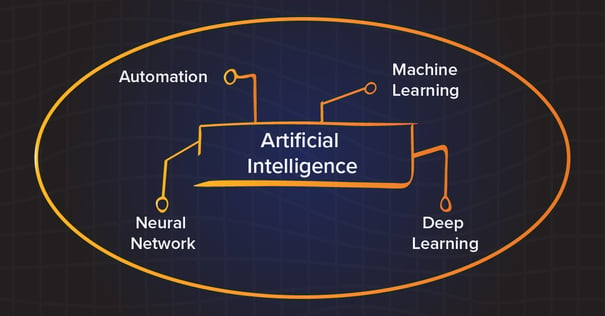Introduction
There is no doubt that the rise of AI tools in sales has the potential to revolutionize the industry. And whether we love it or not, AI is here to stay for a while. It appears that the majority of high-performing sales organizations (57%) are using the technology to improve internal processes and customer experience and studying Salesforce’s “State Of” Report proves that this number is on the rise.
The capability for AI to transform the sales industry is vast, and its adoption is only set to increase. As businesses become more data-driven and customer-centric, there is an increase in the need for AI tools to manage and analyze customer data in real-time. And with the market for AI software expected to reach $37 billion by 2025, there is no doubt that the sales industry will be a major driver of this growth. However, the potential of AI extends far beyond what we have seen so far. As the technology continues to evolve, we can expect to see even more innovative applications emerge, from complex predictive sales analytics to even more developed automated customer service. Today, with Open.ai’s Chat GTP writing page-long text in seconds and algorithms inventing drug molecules to cure OCD, the array of AI capabilities seems endless, and so do the opportunities to leverage artificial intelligence.

Understanding the Differences: Automation, AI, Deep Learning, Machine Learning, and Neutral Network
The line between all concepts appears blurred and although all are related, there are major differences between them. Having a better understanding of different technologies allows us to make more informed decisions when it comes to the use of AI.
1.Automation: It refers to the use of technology to perform tasks that would otherwise be performed by humans. This can include simple and repetitive tasks that follow pre-programmed rules like data entry, personalization, or more complex ones like manufacturing and logistics. The majority of automation uses traditional software that simply moves data, while AI has the capability to understand that data.
2.Artificial Intelligence: AI on the other hand, refers specifically to the ability of machines to learn from historical data and perform tasks that would mimic or go beyond human capabilities such as visual perception, speech recognition, decision-making, and language translation. AI uses machine learning algorithms, statistical models, and neural networks to process and analyze data, learn from it, and make predictions or decisions.
3.Machine Learning: ML is one of the subcategories of artificial intelligence that automatically learns insights, recognizes patterns from data, and applies that learning to make decisions. It gives the systems the ability to learn without being programmed to do so and is focused on using statistical techniques to enable performance improvement on a specific task by learning from data. Machine learning is used in a wide range of applications, including image and speech recognition, natural language processing, fraud detection and medical diagnosis.
4.Deep Learning: DL is a specialized approach of machine learning that runs many AI applications and services. It extracts and learns from data to create multiple models by understanding patterns and trends which are then translated into information. Although it is inspired by the functions of human brain, it already surpasses human capabilities by analyzing data at extremely abstract levels. DL algorithms are used in our everyday life, from Alexa and Siri to object detection in lane assist in cars.
5.Neural Network: It plays a paramount role in artificial intelligence. This algorithm is growing at a rate of 40% each year and is expected to reach 163 trillion gigabytes by 2025 and is designed to imitate how a human brain works. Made up of layers of artificial neurons, it inputs a prediction based on values within its algorithm. Neural network is an algorithm composed of a few layers of nodes, while DL is a technique consisting of multiple layers of neural network.
Both machine learning and AI can be hugely beneficial in many industries if used correctly. By feeding them correct and complete data, and knowing when and how to use them, a collaboration between a human brain and artificial intelligence has the potential to achieve remarkable results.
What Role Does AI Play in Sales?
Right now, AI can be included in every step during the sales cycle. However, despite its capabilities, it doesn’t and may never exclude human input entirely but rather change the way we work. And with automating repetitive tasks and analyzing large amounts of data, AI can help sales reps work more efficiently, while also providing valuable insights that can help them make more informed decisions.
AI-powered chatbots can also help streamline the sales process, tending to customers’ queries while freeing up sales reps to focus on more high-level tasks like relationship-building and closing deals. By identifying patterns and trends in customer behavior, AI can help sales organizations predict customer needs and preferences, allowing them to tailor their approach and provide more personalized service.
Here are a few examples of how AI can boost productivity, improve decision-making, and drive revenue growth:
Lead Generation and Qualification:
Lead generation is complex, especially in the B2B ecosystem. Lead generation and research alone consume about 21% of a B2B sales rep’s time and at least half the budget of most marketers. And despite best efforts, nearly 79% of leads never convert. It is no wonder that Demand Gen AI solutions are thriving, and we see a rise in the number of platforms streamlining lead generation processes. For example, one of 6sense’s primary focuses is on predictive analytics - capturing relevant data from potential buyers, mapping decision-maker behavior, uncovering intent, and predicting in-market accounts. This allows sales teams to put their efforts into the leads that will most likely convert, eliminating guesswork.
Customer Engagement:
Personalization: AI personalization goes beyond what simple automation can do. Today, AI combined with CDP (Customer Data Platform) can speak the language of your audience and help sales reps tailor their approach to each individual customer, using data on their behavior and preferences to provide a customized experience. This data can then be used to create personalized experiences for each customer, tailoring the sales pitch and messaging to match their specific needs and interests.
Solutions like Nytro.ai use artificial intelligence to evaluate and analyze demo pitch recordings of customer-facing reps. Using multiple machine learning techniques, the platform can quickly determine a rep's pitch performance.
Chatbots, Voice Assistants, Appointment Schedulers: Today’s chatbots have come a long way since chatbots (chatterbots) were first introduced in 1966, or even the ones we remember from a few years ago. Natural language processing (NLP) used today allows chatbots and voice assistants to understand and interpret complex messages and respond accurately. Standing on top of one of the main benefits which is freeing up sales reps and customer service agents' time, they also greatly improve response time while boosting customer engagement.
According to Conversica “34% of contacts can’t find answers to simple questions, so they turn to a chatbot, but 87% of users are dissatisfied with the scripted chatbots.” Generative AI stays away from scripted responses and instead offers an authentic experience through dynamic engagement while capturing data and insights along the way.
Sentiment Analysis: In marketing, sentiment analysis (or opinion mining) is used as a form of social listening to gauge audiences’ perceptions of a brand, product, or service. It monitors social media channels and online reviews to identify potential issues and proactively address them. In customer service, sentiment analysis can be used to categorize customer feedback and prioritize responses based on the level of urgency. By understanding customer sentiment, sales teams can tailor their approach and messaging to address customer concerns and improve overall satisfaction.
Sales Analytics and Forecasting:
Sales reps drowning in data appear to be outdated. AI helps in creating precise forecasting from building accurate predictions to real-time updates on sales performance. This allows sales teams to quickly react to changes in the market or customer behavior and recognize sales opportunities. Identifying patterns and trends in data can reveal insights into market dynamics that may not be apparent to the human eye. Automating the forecasting process is especially valuable in the sales industry, where there's a wealth of data to filter, including customer demographics, sales figures, market trends, and more.
AI can also help identify anomalies in the data, such as customers who are at risk of churning, and with today’s emphasis on customer retention, this counts as one of the more valuable uses of AI. Platforms like Gong.io allow for quick identification of legitimate risks in your pipeline, tracking of strategic initiatives as well as turning daily tasks into an automated live list of deal-winning moves you can act on.
Staying Ahead of the Competition
Even though AI has enormous potential to transform businesses, barriers to its adoption still exist. Costs associated with the implementation of AI-based technologies, lack of understanding or expertise, and data challenges are among the most common concerns our clients mention to our experts.
But those challenges don’t necessarily mean that the AI doors are closed to them. Outsourcing is one of the best solutions to still utilize the power of AI tools in your sales cycle and a way for you to test innovative technologies while having the confidence to experiment in a safe data and regulatory environment. At MarketStar, we work with and understand the industry, the latest trends, and tools. In fact, we actively work to find the best solutions to provide profitable revenue for our clients. Maintaining a leading position without the use of automation or AI proves to be more challenging each year, but utilizing an outsourcer who is using the latest technology is becoming more accessible and a proven recipe for growth.








